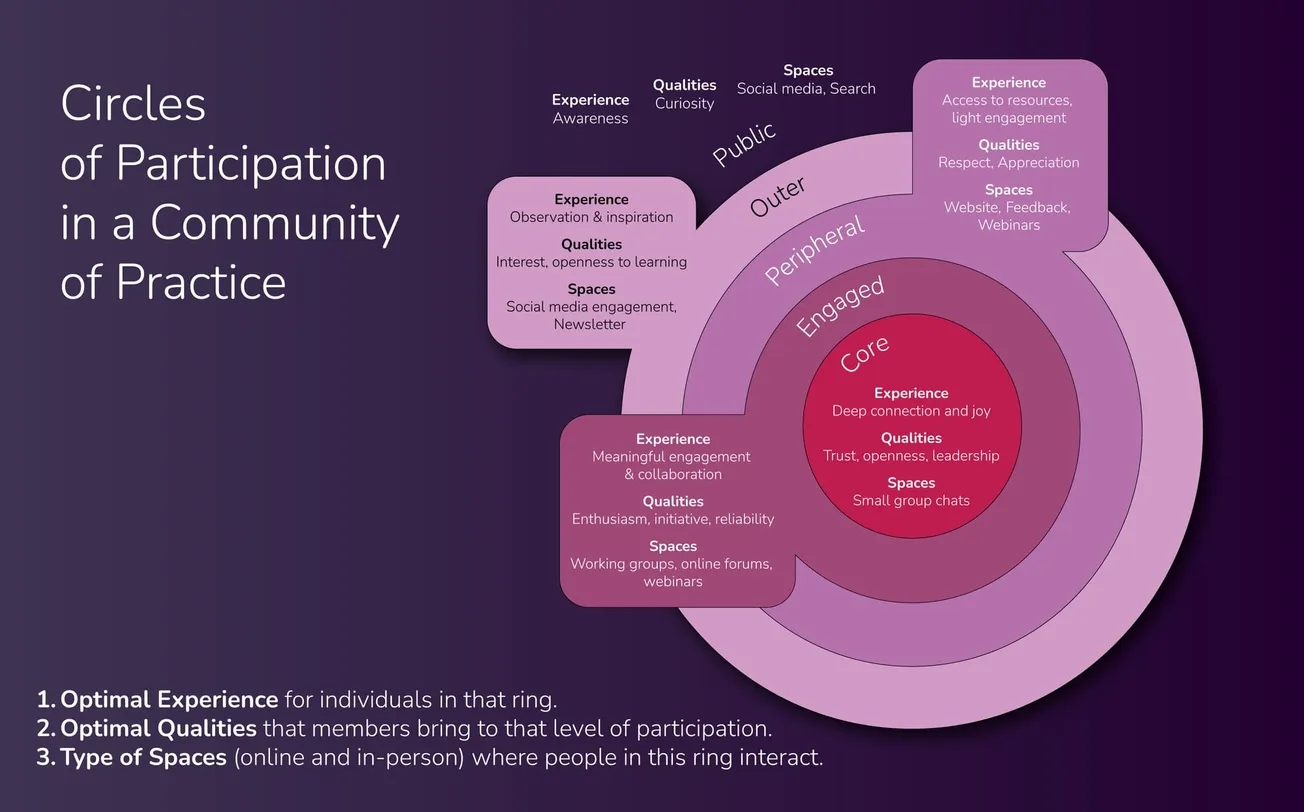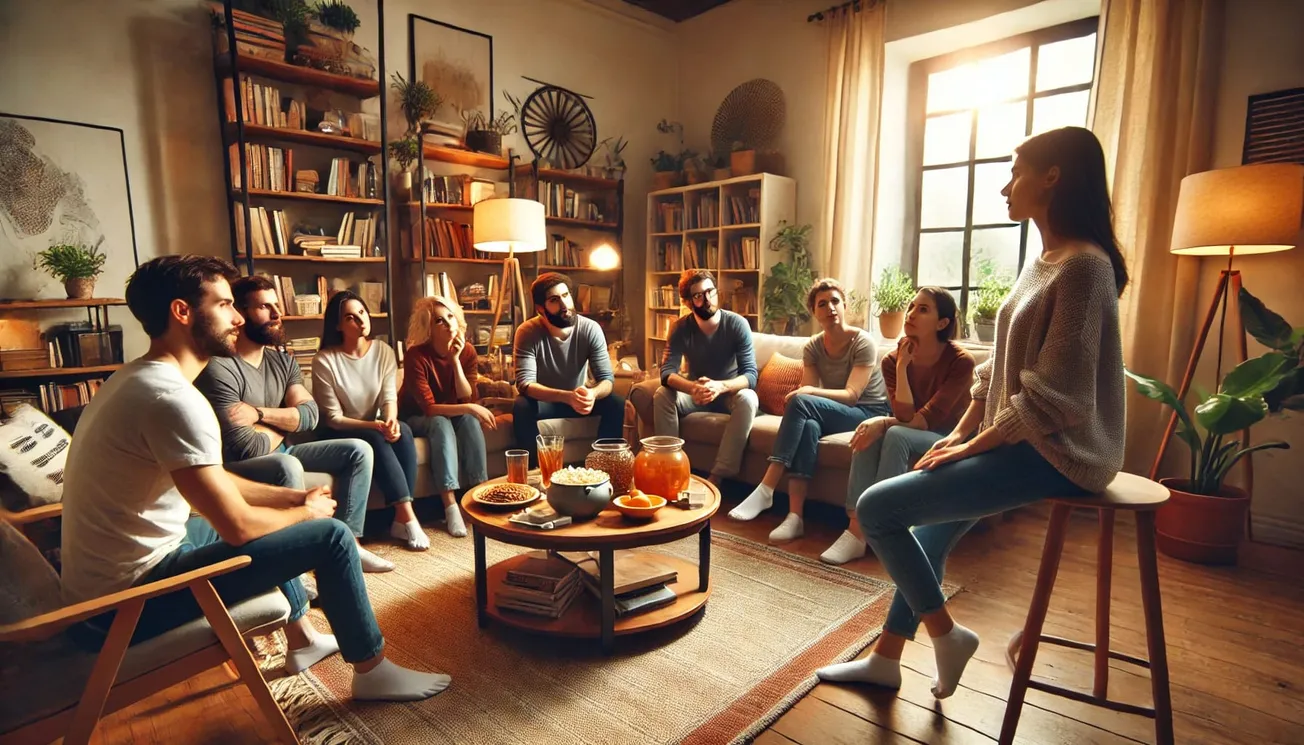Table of Contents
A great community, like a great party, is one you don’t want to leave. It’s vibrant, welcoming, and full of opportunities to grow, share ideas, and collaborate on meaningful projects.
But creating genuinely great communities—especially in our chaotic digital-first world—isn’t simple. To make communities of practice that are not only welcoming but also useful, we need to rethink how they’re designed. At CanAdapt, we aim to help people increase their skills and capacity, make better collective decisions, and take action through new collaborations. To do that, we are embracing a more dynamic and inclusive view of community, something that looks like the radiating ripples in a pond.
Communities That People Want to Belong To
In many traditional communities, status and influence are tied to proximity to the “center”. Everything revolves around a few charismatic figures, and everyone else is ranked by how close they are to that center. This is exemplified in celebrity culture – what social scientists call a parasocial structure – people at the center have no connection at all with people outside the inner circle. This digitally mediated social structure is alienating and counter to how healthy communities actually function.
On the other hand, imagine a community that feels like a great party. People who genuinely enjoy being together, share a sense of purpose and create an atmosphere of joy, openness, and inclusion, and are welcoming to new guests and take care of the people around them. The center of the party radiates generosity outward, creating space for others to participate at their level without creating pressure to conform or compete. Members move freely between levels of engagement, finding a spot that works for them at the moment while still feeling like they belong.
This idea of radiating circles aligns with insights from Social Network Analysis (SNA), which emphasizes the importance of both strong and weak ties in creating networks that are cohesive yet flexible. It also aligns with research on community structures that promote prosocial behaviour. By nurturing communities where participation feels natural and fluid, we make it easy for people to join, engage, and contribute without fear of exclusion.
Research on community detection in networks shows that strong communities often have overlapping and fluid subgroups, which allow members to engage in ways that feel right for them. At CanAdapt, we’re designing community technology that allows for participation that is loose enough to accommodate different needs but coherent enough to maintain a shared sense of purpose.
In community of practice theory this is called legitimate peripheral participation (LPP) and describes how newcomers become experienced members and eventually old timers of a community of practice or collaborative project.
Circles Defined
At CanAdapt, we classify participation in concentric circles. Each circle is defined by the optimal experience to be had, the optimal qualities that members bring, and the spaces where participation occurs:
1. Core Circle
- Optimal Quality of Experience: Deep connection, trust, and a sense of belonging.
- Optimal Qualities that Members Bring: Leadership, openness, friendship, initiative, and a shared commitment to the community’s purpose.
- Types of Spaces of Participation: Small group chats, meals, private meetings, collaborative project spaces, and retreats.
2. Engaged Circle
- Optimal Experience: Meaningful engagement, active collaboration, and opportunities for skill development.
- Optimal Member Qualities: Enthusiasm, dependability, curiosity, and a willingness to take on responsibility.
- Types of Spaces: Working groups, interactive webinars, online forums, and regular in-person meetupsnd parties.
3. Peripheral Circle
- Optimal Experience: Access to resources, light engagement, and opportunities to observe or participate occasionally.
- Optimal Member Qualities: Respect, curiosity, and occasional contributions or feedback.
- Types of Spaces: Public channels, newsletters, open-access webinars, and community-wide events.
4. Outer Circle
- Optimal Experience: Observation, inspiration, and casual engagement.
- Optimal Member Qualities: Interest, openness to learning, and passive participation (e.g., liking, sharing content).
- Types of Spaces: Social media groups, community blogs, and publicly available content repositories.
5. Public (Outer environment)
- Optimal Experience: Awareness and general interest in the community’s mission or output.
- Optimal Qualities: General interest, curiosity, respect.
- Types of Spaces: Public-facing social media, websites, and media coverage.
CanAdapt's Circles of Participation Model ensures that each level of engagement has a defined role and purpose, from the deeply involved core to casual observers in the public sphere. Each circle aligns with the diverse needs and capacities of participants while fostering inclusivity and accessibility across the community.
Communities as Interconnected Ecosystems
Great communities don’t exist in isolation—they’re part of larger ecosystems of interconnected groups. This perspective is supported by social identity complexity, which recognizes the value of overlapping identities and networks and bridging social capital in which overlapping social identities through multiple group memberships connect diverse groups and promote exchanges of ideas, fostering innovation and resilience. At CanAdapt, we encourage our members to engage across different communities, creating a web of support and collaboration that amplifies their impact. You might join CanAdapt to connect with peers working on climate adaptation in the energy sector while participating in a community focused on ecosystem health. These overlapping communities strengthen one another by sharing knowledge, resources, and energy, creating a ripple effect of positive change.
Recommendations for Building Great Communities of Practice
So here's some practical things we've learned about creating communities that are welcoming, useful, and action-oriented:
1. Focus on Connection at the Core: Cultivate a welcoming and joyful environment at the heart of the community. Think of it like hosting a great party—create a space where people feel valued, included, and excited to engage. Set up high contact spaces like a Signal or WhatsApp group and have lots of time together. Become close friends.
2. Design for Growth and Action: Build structures that help people develop new skills, generate better collective ideas, and collaborate effectively on real-world projects. Encourage open sharing and co-creation, as emphasized by the produsage model.
3. Establish Pro-Social Norms: Create clear, flexible guidelines for how members engage with each other. Foster a culture of respect, accountability, and adaptability, drawing from inclusive community-building frameworks.
4. Embrace Flexibility: Design for fluid participation, allowing people to move between levels of engagement without fear of exclusion. Use tools from Social Network Analysis (SNA) to identify and support natural subgroups within the network.
5. Leverage Interconnectedness: Recognize that no community exists in isolation. Foster connections with other networks, creating a broader ecosystem of collaboration. Draw from intersectional solidarity to encourage overlapping and mutually supportive communities.
A Vision for Communities of Practice
At CanAdapt, our vision is to create communities of practice that people are excited to join. These communities aren’t just networks of people; they’re ecosystems of support, innovation, and collective intelligence.
When communities are built this way, they become more than just places to connect—they become spaces where members thrive as individuals and as part of a collective. They’re like a great party: you’re glad you were invited, you’re excited to be there, and you never want to leave.






